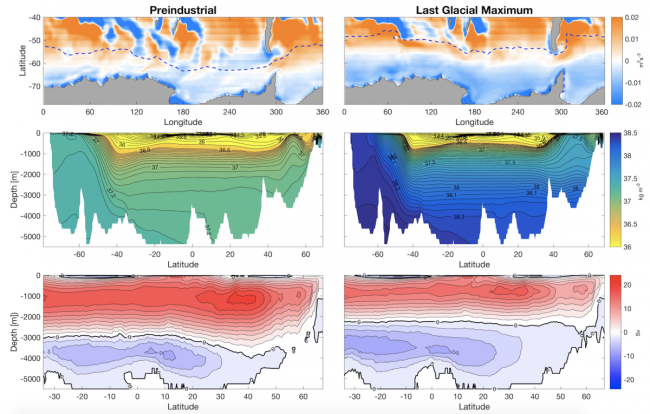The role of Antarctic sea ice in shaping modern and glacial deep ocean circulation
Since the onset of the Northern Hemisphere glaciation (~ 2.7 million years ago), Earth’s climate has undergone large transitions between cold “glacial” and warm “interglacial” (e.g., present-day) stages. The paleoclimate record suggests that these transitions were accompanied by changes in the ocean’s water mass distribution, which likely played a key role in the glacial-interglacial shifts themselves, by affecting ocean carbon storage and thus atmospheric CO2 concentrations. However, we still lack a quantitative understanding of the physical mechanisms leading to the suggested changes in ocean circulation, which inevitably challenges our interpretation of past and present climates and shakes our confidence in future projections.

The representation of the glacial ocean state and circulation in coupled climate simulations differs substantially between models and is often at odds with the geological evidence. Such inconsistencies may cast some doubts on the reliability of these models, which are also used to simulate future climate scenarios. To better understand these discrepancies, a recent study published in Geophysical Research Letters investigates the drivers of changes in deep ocean circulation across a range of modern and Last Glacial Maximum (LGM, ~21000 years ago) climate simulations from the latest Paleoclimate Modelling Intercomparison Project (PMIP).
This study specifically considers the role of Antarctic sea ice in shaping deep ocean circulation and stratification, by driving surface buoyancy loss associated with brine rejection (when sea ice forms, salt is pushed into the surrounding seawater, making it denser). The researchers show that models simulating strong LGM sea ice formation also exhibit enhanced stratification and a shallower Atlantic Meridional Overturning Circulation (AMOC), largely consistent with the geological evidence. LGM simulations with relatively little Antarctic sea ice, instead, typically reveal stratification and circulation changes opposite to those suggested by most paleoclimate reconstructions.
This analysis indicates that most of the apparent inconsistencies between different models can be reconciled and attributed to differing (and likely insufficient) Antarctic sea ice formation. Such biases would also affect simulations for present and future climate scenarios, highlighting the importance to carefully consider the representation of high-latitude climate and sea ice processes in coupled climate models. Discrepancies in the glacial climate simulations are further amplified by short integration times, as the deep ocean equilibrates on millennial timescales. Results from relatively short simulations should, therefore, be interpreted with caution when comparing to the paleoclimate record. Deep ocean equilibration should also be carefully evaluated in the forthcoming PMIP4 simulations.
Connecting Antarctic sea ice to deep-ocean circulation in modern and glacial climate simulations (Geophysical Research Letters)
1The University of Chicago
Topics
- Sea Ice
- Paleo
- Modeling
- Antarctica
- AMOC
